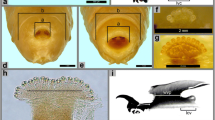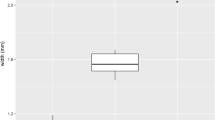Abstract
Flies of family Piophilidae have been recorded as major pests in the food industry, as agents of human myiasis and typically associated with carcasses in advanced stages of decay, being thus important in forensic entomology. Despite that the cosmopolitan species Piophila casei is the most cited in entomological studies, many other piophilid species develop on both carrion and animal products from the food industry. One of those species is Prochyliza nigrimana, widely distributed throughout the Holarctic and Neotropical regions. In this study, the morphological features of the immature stages of P. nigrimana are described for the first time and compared with those of P. casei. The third-instar larvae and puparium of P. nigrimana are significantly shorter than those of P. casei; the contrary pattern is observed in egg length. The number and arrangement of the lobes of anterior spiracles, which had been used as a distinctive character of P. casei in some keys, are the same in both species. Morphological features of the cephaloskeleton (such as the general shape and the distance between the tips and the base of the mouth hooks/base of the mouth hooks ratio), the arrangement of anal segment in third-instar larvae and the appearance of the ventral creeping welts in the puparium are the main characters allowing for identification of both species.





Similar content being viewed by others
References
Adams ZJO, Hall MJR (2003) Methods used for the killing and preservation of blowfly larvae, and their effect on post-mortem larval length. Forensic Sci Int 138:50–61
Amendt J, Richards CS, Campobasso CP, Zehner R, Hall MJR (2011) Forensic entomology: applications and limitations. Forensic Sci Med Pathol 7:379–392
Boehme P, Amendt J, Zehner R (2011) The use of COI barcodes for molecular identification of forensically important fly species in Germany. Parasitol Res. doi:101007/s00436-011-2767-8
Bonduriansky R (2002) Leaping behaviour and responses to moisture and sound in larvae of piophilid carrion flies. Can Entomol 134:647–656
Bonduriansky R, Brooks RJ (1999) Reproductive allocation and reproductive ecology of seven species of Diptera. Ecol Entomol 24:389–395
Brindle A (1965) Taxonomic notes on the larvae of British Diptera No. 21—the Piophilidae. Entomol 78:158–160
Courtney GW, Sinclair BJ, Meier R (2000) Morphology and terminology of Diptera larvae. In: Papp L, Darvas B (eds) Contribution to a manual of Palaearctic Diptera (with special reference to flies of economic importance), vol 1. Science Herald Press, Budapest, pp 85–161
Duda O (1924) Revision der europäischen u. grönländischen sowie einiger südostasiat. Arten der Gattung Piophila Fallén (Dipteren). Konowia 3:97–113, 153–203
Ferrar P (1987) A guide to the breeding habits and immature stages of Diptera Cyclorrapha. Entomonograph 8:1–907
Freidberg A (1981) Taxonomy, natural history and immature stages of the bone-skipper, Centrophlebomyia furcata (Fabricius) (Diptera: Piophilidae, Thyreophorina). Entomol Scand 12:320–326
Grzywacz A, Pape T, Szpila K (2012) Larval morphology of the lesser housefly, Fannia canicularis. Med Vet Entomol 26:70–82
Han HY, Ro KE (2005) Molecular phylogeny of the superfamily Tephritoidea (Insecta: Diptera): new evidence from the mitochondrial 12S, 16S, and COII genes. Mol Phylogenet Evol 34:416–430
Hennig W (1943) Piophilidae. In: Lindner E (ed) Die Fliegen der Palaearktischen Region, vol 5. Schweizerbart, Stuttgart, pp 1–52
Keilin D (1944) Respiratory systems and respiratory adaptations in larvae and pupae of Diptera. Parasitology 36:1–66
Kitching RL (1976) On the prothoracic spiracles of the first instar larvae of Calyptrate Cyclorrapha (Diptera). J Aust Entomol Soc 15:233–235
Liu D, Greenberg B (1989) Immature stages of some flies of forensic importance. Ann Entomol Soc Am 82:80–93
Martín-Vega D (2011) Skipping clues: forensic importance of the family Piophilidae. Forensic Sci Int 212:1–5
Martín-Vega D, Baz A (2011) Variation in the colour of the necrophagous fly, Prochyliza nigrimana (Diptera: Piophilidae): a case of seasonal polymorphism. Eur J Entomol 108:231–234
Martín-Vega D, Gómez-Gómez A, Baz A, Díaz-Aranda LM (2011) New piophilid in town: the first Palaearctic record of Piophila megastigmata and its coexistence with Piophila casei in central Spain. Med Vet Entomol 25:64–69
McAlpine JF (1977) A revised classification of the Piophilidae, including ‘Neottiophilidae’ and ‘Thyreophoridae’ (Diptera: Schizophora). Mem Entomol Soc Can 103:1–66
Mégnin P (1894) La faune des cadavres. Application de l’entomologie a la médecine légale. In: Léauté M (ed) Encyclopédie Scientifique des Aide-Mémoire, vol 101B. Masson-Gauthier-Villars et Fills, Paris, pp 1–214
Meigen JW (1826) Systematische Beschreibung der bekannten europäischen zweiflügeligen Insekten, vol. 5. Hamm
Niederegger S, Wartenberg N, Spieβ R, Mall G (2011) Simple clearing technique as species determination tool in blowfly larvae. Forensic Sci Int 206:e96–e98
Nielsen P, Ringdahl O, Tuxen SL (1954) Diptera 1 (exclusive of Ceratopogonidae and Chironomidae). Zool Iceland 3:1–189
Ozerov AL (2000) Family Piophilidae. In: Papp L, Darvas B (eds) Contribution to a manual of Palaearctic Diptera (with special reference to flies of economic importance), Appendix. Science Herald Press, Budapest, pp 355–365
Ozerov AL (2004) On the classification of the family Piophilidae (Diptera). Zool Zh 83:1353–1360 (In Russian)
Pancorbo MM, Ramos R, Saloña M, Sánchez P (2006) Entomología molecular forense. Ciencia Forense 8:107–130
Peckenschneider LE, Pokorny C, Hellwig CA (1952) Intestinal infestation with maggots of the “cheese fly” (Piophila casei). JAMA 149:262–263
Pérez Íñigo C (1971) Dípteros y coleópteros pseudoparásitos del intestino humano. Graellsia 27:161–176
Prado e Castro C, García MD (2010) Additions to the Piophilidae (Diptera) fauna from Portugal, with new records. Graellsia 66:101–105
Saleh MSM, el Sibae MM (1993) Urino-genital myiasis due to Piophila casei. J Egypt Soc Parasitol 23:737–739
Simmons P (1927) The cheese skipper as a pest in cured meats. US Dept Agric Bull 1453:1–55
Smith KGV (1986) A manual of forensic entomology. British Museum (Natural History) and Cornell University Press, London
Steyskal GC (1968) Notes on North American Piophilidae. III. Proc Entomol Soc Wash 70:25–27
Sukontason KL, Sukontason K, Piangjai S, Choochote W, Vogtsberger RC, Olson JK (2001) Scanning electron microscopy of the third-instar Piophila casei (Diptera: Piophilidae), a fly species of forensic importance. J Med Entomol 38:756–759
Sukontason KL, Ngern-Klun R, Sripakdee D, Sukontason K (2007) Identifying fly puparia by clearing technique: application to forensic entomology. Parasitol Res 101:1407–1416
Sukontason K, Sribanditmongkol P, Ngoen-klan R, Klong-klaew T, Moophayak K, Sukontason KL (2010) Differentiation between Lucilia cuprina and Hemipyrellia ligurriens (Diptera: Calliphoridae) larvae for use in forensic entomology applications. Parasitol Res 106:641–646
Syed A (1994) Notes on the biology and rearing of the carrion fly Prochyliza brevicornis (Melander) (Diptera: Piophilidae). J Entomol Soc B C 91:55–57
Velásquez Y, Magaña C, Martínez-Sánchez A, Rojo S (2010) Diptera of forensic importance in the Iberian Peninsula: larval identification key. Med Vet Entomol 24:293–308
Webb JE, Graham HM (1956) Observations on some filth flies in the vicinity of Fort Churchill, Manitoba, Canada, 1953–54. J Econ Entomol 49:595–600
Zuska J, Laštovka P (1965) A review of the Czechoslovak species of the family Piophilidae with special reference to their importance to food industry (Diptera, Acalyptrata). Acta Entomol Bohemoslov 62:141–157
Acknowledgments
We are grateful to Dr. Juan Junoy for lending us his microscopy and photography equipment. Two anonymous reviewers provided useful comments and suggestions which improved the manuscript. This work has been funded by the IUICP (Instituto Universitario de Investigación en Ciencias Policiales) of the University of Alcalá (Project IUICP/PI2010/001). DMV was supported by a grant from the IUICP.
Author information
Authors and Affiliations
Corresponding author
Rights and permissions
About this article
Cite this article
Martín-Vega, D., Baz, A. & Díaz-Aranda, L.M. The immature stages of the necrophagous fly, Prochyliza nigrimana: comparison with Piophila casei and medicolegal considerations (Diptera: Piophilidae). Parasitol Res 111, 1127–1135 (2012). https://doi.org/10.1007/s00436-012-2943-5
Received:
Accepted:
Published:
Issue Date:
DOI: https://doi.org/10.1007/s00436-012-2943-5




